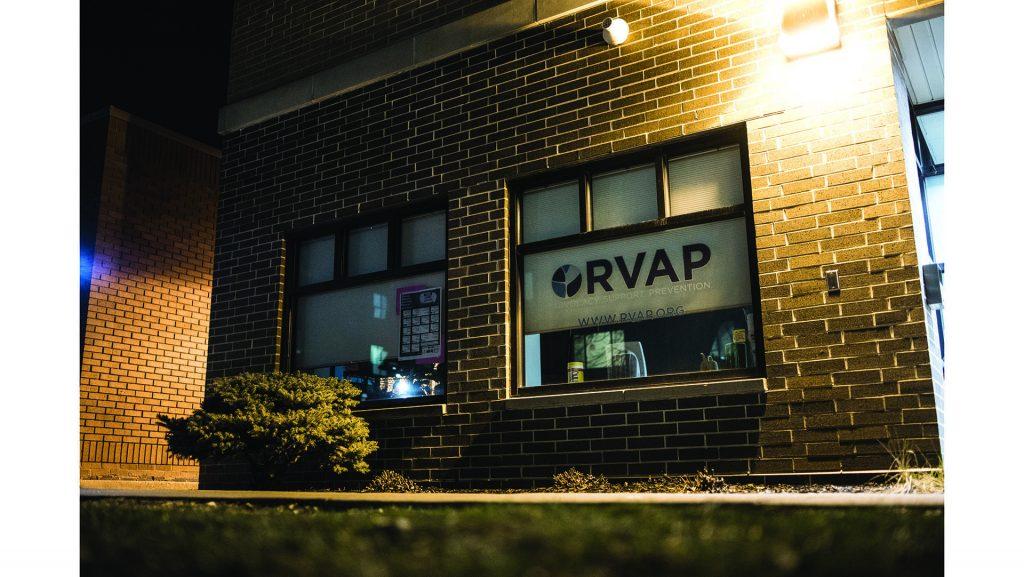University of Iowa releases results of third Speak Out Survey, new anti-violence plan
The survey includes University of Iowa students’ experience with sexual misconduct.
RVAP is pictured on Thursday, April 5, 2018.
September 30, 2021
The University of Iowa unveiled a new Anti-Violence Plan on Thursday along with the results of the university’s third Speak Out Iowa survey on sexual assault and harassment.
The plan outlines nearly 40 recommendations in prevention and education, intervention, and policy changes that the campus Anti-Violence Coalition developed in response to the survey’s findings.
Key recommendations from the report include:
- Increase tools and easy-to-access education for students to understand healthy relationships and sexuality.
- Create a tiered education program for fraternity and sorority life members and a men’s peer program for fraternity members.
- Convene a summit with Iowa school district leaders, state legislators, and others to outline strategies for education that emphasizes healthy relationships in Iowa’s middle and high schools
- Create a video on digital harassment
- Increase accessibility and understanding of resources like Title IX support and where to report sexual misconduct
- Use technology and apps to raise awareness of violence and provide resources
The 2021 Speak Out Survey, administered in the spring semester of 2021, was the third survey of its type. The UI administered the survey in 2015 and in 2017.
The survey was administered to all degree-seeking students at the University of Iowa. Itw as answered by 4,268 people for a response rate of 15.54 percent.
“The results of the Speak Out Iowa survey provide us with tremendous insight that we use to create plans and policies that support our community. We are always gathering student feedback, which helped shape this year’s additions to the survey. This approach allows us to focus on specific, emerging issues and address them head-on,” Vice President for Student Life Sarah Hansen said in a press release.
Across the board, 25.7% of women, 8.4% of men, and 28.8% of transgender or gender non-conforming students who took the survey reported they’d experienced some type of sexual violence since enrolling at the UI.
This year’s survey was the first to include questions about digital harassment, which includes harassing messages, sharing sexually explicit photos, or repeated and unwanted sexual requests.
“We thought this was timely both because students were spending more time in online environments during the height of the pandemic, and also because we know that this particular age population of students, technology is a huge part of their life,” said Carolyn Hartley, co-chair of the subcommittee of the Anti-Violence Coalition that administered the survey.
The survey found that cisgender women and transgender and gender-nonconforming people reported the most digital harassment. The transgender and gender non-conforming category included students that identified as transgender, non-binary, genderqueer, or gender non-conforming.
Another finding from the report was while respondents had a high level of confidence in asking for consent, less than half reported that they always verbally asked for consent before initiating a sexual encounter.
39.5 percent of women, 47.4 percent of men, and 58.4 percent of transgender and gender non-conforming people said they always verbally asked for consent.
UI Title IX coordinator Monique DiCarlo said the UI’s prevention training going forward would incorporate scenario-based applications of the skills taught in sexual misconduct prevention trainings.
“‘Some of that will be doing more focus groups with students to understand what their experiences are and letting that feedback and information inform what the programs are and what they look like,” she said.
Also new to this year’s survey were questions about how sexual misconduct affects academic performance. The survey found that students who experience sexual misconduct suffer short- and long-term academic pitfalls, varying based on the type of misconduct.
The most common reactions to sexual misconduct among those who responded was missing or being late to class and delaying or failing an assignment. Of those responses, dating violence and sexual violence were the most likely to incur negative academic outcomes.
“Students who experience dating violence and sexual violence reported significantly more impacts on their short-term academic progress … [and] long term academic impacts,” Hartley said.
Fraternities and sororities
Three of the report’s recommendations included programming geared specifically toward fraternities and sororities.
The recommendations include piloting new programming for fraternities and sororities based on the students’ tenure in that community. Another recommendation is to “pilot Fraternity Men’s Peer conversation program about authentic masculinities.”
The survey report included a breakdown of incident factors in respondents’ reports of sexual violence, including location. According to the report, 5.3 percent of the incidents that happened in a residence or residence hall were in a fraternity or sorority house. 32.8 percent were in a UI residence hall.
Reporting misconduct
Of the students who experienced misconduct, 10.6 percent of respondents reported the incident to a UI office. The most frequently reported to offices were:
- Counselor or therapist at University Counseling Service or Student Health and Student Wellness (40.2 percent)
- Office of the Sexual Misconduct Response Coordinator (24 percent)
- UI Department of Public Safety (20.5 percent)
- Rape crisis advocate or counselor at the Rape Victim Advocacy Program (20.5 percent)
A little over half of the women who responded to the survey, 57.1 percent, said they think the UI would handle a report of sexual misconduct fairly. For transgender and gender non-conforming students, that number was lower, at 46.3 percent, and 67.6 percent of men said they thought the university would handle a report fairly.
Even less people said they knew where to go to make a report of sexual misconduct and that they understood the sexual misconduct reporting process.
Of the women who responded, 42.9 percent said they knew where to go to make a report of sexual misconduct, while 56.3 percent of men and 46.2 percent of transgender and gender non-conforming people said the same.



